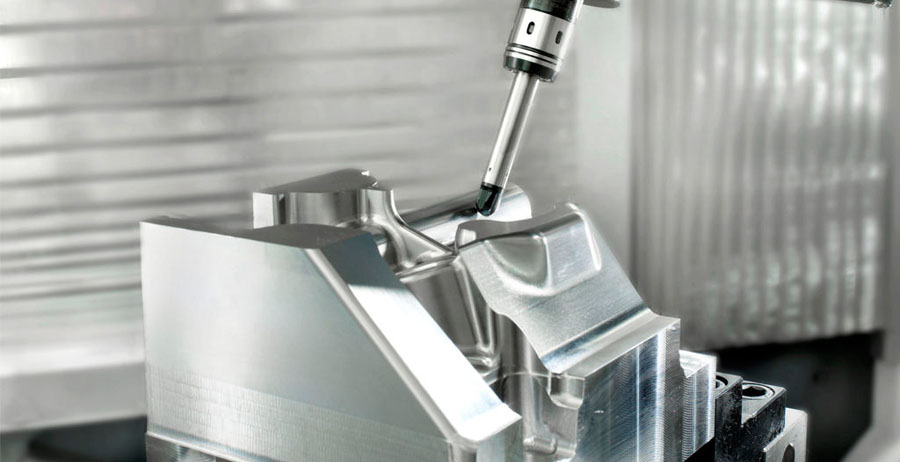In CNC milling, achieving the target dimensions is only half the battle. The quality of the surface finish is often the true measure of a well-executed machining process. A flawless finish not only speaks to the skill of the machinist and the quality of the equipment but is also critical for the functional performance of the part, affecting everything from friction and wear to fatigue life and corrosion resistance.
However, a perfect surface can be elusive. The milling process is a complex interplay of forces, vibrations, and thermal effects that can manifest as a variety of surface defects. This guide provides a systematic approach to identifying, understanding, and solving the most common surface finish problems.
Defect #1: Prominent Tool Marks or Feed Lines
What it looks like: Visible, evenly spaced lines or ridges that follow the tool’s path. While all milling leaves some witness marks, these are pronounced enough to be seen or felt easily, giving the surface a “scalloped” or grooved appearance.
Common Causes:
Feed Rate is Too High for the Tool Nose Radius: The size of the scallop is a direct function of the feed per tooth and the tool’s corner radius (or the effective radius on a ball-end mill). A high feed rate with a small radius will create deep scallops.
Tool Runout: If the tool is not perfectly concentric with the spindle’s axis of rotation, one cutting edge will be taking a larger chip than the others. This “limping” effect leaves a once-per-revolution mark that looks like a heavy feed line.
Worn or Chipped Cutting Edge: A damaged cutting edge will no longer shear the material cleanly, instead plowing through it and leaving a smeared or irregular groove.
How to Fix It:
Optimize Your Feeds and Speeds: For finishing passes, decrease the feed per tooth (IPT) or increase the tool’s corner radius. Using a larger-diameter cutter or a dedicated “wiper” insert, which has a small flat on the nose, is highly effective at smoothing out these marks.
Check and Minimize Runout: Ensure your tool holder, collet, and spindle are clean and free from damage. Use a high-quality, precision-ground tool holder. For critical applications, measure the tool’s runout with a dial test indicator and adjust or re-clamp as necessary. A runout of more than 0.0005″ (0.012mm) can be problematic.
Inspect and Replace Tooling: Regularly inspect cutting edges for wear or micro-chipping, especially when working with abrasive materials. Don’t hesitate to use a fresh tool or insert for the final finishing pass.
Defect #2: Chatter Marks
What it looks like: A distinctive, wavy, or snake-skin pattern on the surface, often accompanied by a loud, high-pitched squealing sound during the cut. The marks are typically perpendicular to the direction of feed.
Common Causes:
Chatter is a self-exciting vibration, or resonance, in the machining system. The root cause is a lack of rigidity somewhere in the chain.
Tooling and Holder Setup: The tool is sticking out too far from the holder, or the tool holder itself is long and slender.
Workpiece Clamping: The part is not held rigidly, or the feature being machined is a thin wall or floor that can easily vibrate.
Machine Condition: Worn spindle bearings or loose gibs on the machine axes can introduce slop and reduce overall rigidity.
Cutting Parameters: An incorrect combination of radial/axial depth of cut and spindle speed excites the natural frequency of the system.

How to Fix It:
Increase Rigidity (The Golden Rule):
- Tooling: Use the shortest, stoutest tool possible for the job. Choke up on the tool in the holder as much as possible. Use high-performance holders (e.g., hydraulic, shrink-fit) instead of standard ER collets for heavy cutting.
- Workholding: Ensure the workpiece is firmly clamped as close to the cutting zone as possible. Add support under thin features if necessary.
Vary the Spindle Speed: Often, a simple 10% increase or decrease in RPM can break the harmonic resonance and eliminate chatter. This is the quickest thing to try.
Adjust Cutting Strategy: Use a tool with a different number of flutes. Employ High-Efficiency Milling (HEM) toolpaths, which use a smaller radial depth of cut (WOC) but a much deeper axial depth of cut (DOC). This changes the forces on the tool and can significantly reduce chatter.
Change Cutter Geometry: Use a variable-helix or variable-pitch end mill. These tools are specifically designed to disrupt the harmonic vibrations that cause chatter.
Defect #3: Burrs
What it looks like: A sharp, raised edge of material left along the edges of the machined surface after the cutter has passed.
Common Causes:
Tool Wear: A dull tool doesn’t shear the material cleanly; it plows and pushes it until it deforms plastically and exits the cut as a burr.
Material Properties: Soft, gummy materials like low-carbon steel, aluminum, and some stainless steels are more prone to forming burrs.
Incorrect Cutting Parameters: A low feed rate can sometimes increase burr formation as the tool rubs rather than cuts.
How to Fix It:
Use Sharp, Coated Tooling: A sharp edge is the number one defense against burrs. Use a high-positive rake geometry and a slick coating (like DLC or ZrN for aluminum) to ensure a clean shearing action.
Use Climb Milling: In climb milling, the tool cuts “down” into the material, creating a chip that is thick-to-thin. This directs cutting forces into the body of the part and tends to produce a smaller burr than conventional milling.
Adjust Toolpaths: Program toolpaths that avoid exiting the material on a sharp, unsupported edge. For example, have the tool “roll” around a corner rather than feeding straight off the edge.
Deburring as a Last Operation: Consider programming a final, very light deburring or chamfering pass with a specialized tool to mechanically remove any remaining burrs before the part leaves the machine.
A Holistic Approach to Quality
Solving surface finish defects is rarely about finding a single magic bullet. It requires a holistic approach that considers the entire machining system:
Start with Stability: A rigid machine, robust workholding, and short, stout tooling are the foundation of any quality finish.
Choose the Right Tool: Always use a sharp, high-quality cutter with the correct geometry and coating for your material.
Optimize the Process: Don’t be afraid to experiment. A small adjustment to your spindle speed, feed rate, or depth of cut can often make all the difference.
Defect #4:Burning
Burning refers to discoloration, hardness changes, or microstructural damage that occurs on the workpiece surface after CNC milling. It can seriously affect the surface quality and performance of the part.
Common Causes:
Excessive cutting speed: When cutting speeds are too high, friction between the tool and the workpiece increases dramatically, generating significant cutting heat. This causes the workpiece surface temperature to rise rapidly, reaching or exceeding the phase transition temperature of the workpiece material. This can lead to changes in the workpiece surface microstructure and cause burns. For example, when milling steel at high speeds, improper cutting speed control can easily cause oxidation and discoloration on the workpiece surface due to the high temperature, or even quench hardening. This increases surface hardness but also reduces the material’s toughness, resulting in surface defects such as cracks.
Inadequate cooling: In CNC milling, coolant lowers cutting temperatures, reduces friction between the tool and the workpiece, and thus improves surface quality. However, insufficient coolant flow, improper spray angle, or improper coolant type can result in poor cooling, preventing the heat generated in the cutting area from being removed promptly, causing the workpiece surface temperature to rise and leading to burns. For example, when processing some materials with poor thermal conductivity, such as titanium alloys and high-temperature alloys, if the coolant cannot fully cool the workpiece, the surface of the workpiece can easily be burned due to heat accumulation.
How to Fix It:
Optimizing Cutting Parameters
Rational selection of cutting parameters is key to improving surface quality in CNC milling. First, the appropriate cutting speed, feed rate, and depth of cut should be determined based on factors such as the workpiece material properties, tool material and geometry, and machining requirements. By establishing a predictive model linking cutting parameters and surface quality, precise selection and optimization of cutting parameters can be achieved to achieve optimal surface quality.
Enhancing Cooling and Lubrication
Cooling and lubrication are important means of reducing cutting temperature, minimizing friction between the tool and workpiece, and improving surface quality. The appropriate coolant type and supply method should be selected based on the workpiece material, tool material, and machining requirements. At the same time, the coolant flow rate and spray angle should be reasonably adjusted to ensure that the coolant can fully cover the cutting area and achieve the best cooling and lubrication effect. In addition, some new cooling and lubrication technologies can also be adopted, such as minimal lubrication technology and liquid nitrogen cooling technology. These technologies can not only improve the cooling and lubrication effect, but also reduce environmental pollution and reduce production costs.
Conclusion
The generation of surface defects in CNC milling is a complex issue, involving multiple aspects such as cutting parameters, cutting tools, workpiece materials, and processing technology. To solve these problems, it is necessary to comprehensively consider various factors and adopt a series of effective measures, from optimizing cutting parameters, selecting appropriate cutting tools, improving tool installation accuracy, adopting appropriate processing strategies, strengthening cooling and lubrication, to adopting advanced detection and compensation technologies. Only by taking a multi-pronged approach can the surface quality of CNC milling be significantly improved to meet the demand of modern manufacturing for high-precision, high-quality parts. At the same time, with the continuous advancement of science and technology, new processing technologies, tool materials and coating technologies, and intelligent control technologies are also constantly emerging. The surface quality control of CNC milling will become more accurate and efficient, providing strong support for the development of the manufacturing industry.



